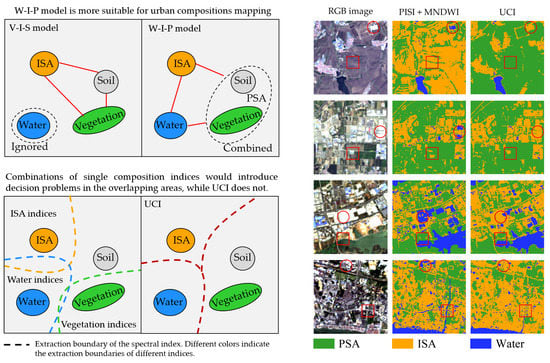A Novel Urban Composition Index Based on Water-Impervious Surface-Pervious Surface (W-I-P) Model for Urban Compositions Mapping Using Landsat Imagery
Abstract
1. Introduction
2. Materials and Methods
2.1. Datasets
2.2. Urban Composition Index (UCI)
2.2.1. Principle and Development of UCI
2.2.2. Threshold Analysis of UCI
2.3. Comparative Analysis with Other Indices
2.3.1. Separability Analysis
2.3.2. Correlation Analysis with ISA Proportion
2.3.3. Accuracy Assessment
3. Results
3.1. Applying UCI to Landsat-8 Images
3.2. Comparisons with Multiple Composition Indices
3.3. Comparisons with Single Composition Indices
4. Discussion
5. Conclusions
Author Contributions
Funding
Acknowledgments
Conflicts of Interest
References
- Antrop, M. Landscape change and the urbanization process in Europe. Landsc. Urban Plan. 2004, 67, 9–26. [Google Scholar] [CrossRef]
- Harbor, J.M. A practical method for estimating the impact of land-use change on surface runoff, groundwater recharge and wetland hydrology. J. Am. Plan. Assoc. 1994, 60, 95–108. [Google Scholar] [CrossRef]
- Weng, Q. Remote sensing of impervious surfaces in the urban areas: Requirements, methods, and trends. Remote Sens. Environ. 2012, 117, 34–49. [Google Scholar] [CrossRef]
- Xian, G.; Crane, M. An analysis of urban thermal characteristics and associated land cover in Tampa Bay and Las Vegas using Landsat satellite data. Remote Sens. Environ. 2006, 104, 147–156. [Google Scholar] [CrossRef]
- Xu, H. Analysis of impervious surface and its impact on urban heat environment using the normalized difference impervious surface index (NDISI). Photogramm. Eng. Remote Sens. 2010, 76, 557–565. [Google Scholar] [CrossRef]
- Yan, Y.; Zhang, C.; Hu, Y.; Kuang, W. Urban land-cover change and its impact on the ecosystem carbon storage in a dryland city. Remote Sens. 2016, 8, 6. [Google Scholar] [CrossRef]
- Sexton, J.O.; Song, X.-P.; Huang, C.; Channan, S.; Baker, M.E.; Townshend, J.R. Urban growth of the Washington, DC—Baltimore, MD metropolitan region from 1984 to 2010 by annual, Landsat-based estimates of impervious cover. Remote Sens. Environ. 2013, 129, 42–53. [Google Scholar] [CrossRef]
- Song, X.-P.; Sexton, J.O.; Huang, C.; Channan, S.; Townshend, J.R. Characterizing the magnitude, timing and duration of urban growth from time series of Landsat-based estimates of impervious cover. Remote Sens. Environ. 2016, 175, 1–13. [Google Scholar] [CrossRef]
- Yu, S.; Sun, Z.; Guo, H.; Zhao, X.; Sun, L.; Wu, M. Monitoring and analyzing the spatial dynamics and patterns of megacities along the Maritime Silk Road. J. Remote Sens. 2017, 21, 169–181. [Google Scholar] [CrossRef]
- Zhang, L.; Weng, Q. Annual dynamics of impervious surface in the Pearl River Delta, China, from 1988 to 2013, using time series Landsat imagery. ISPRS J. Photogramm. Remote Sens. 2016, 113, 86–96. [Google Scholar] [CrossRef]
- Im, J.; Lu, Z.; Rhee, J.; Quackenbush, L.J. Impervious surface quantification using a synthesis of artificial immune networks and decision/regression trees from multi-sensor data. Remote Sens. Environ. 2012, 117, 102–113. [Google Scholar] [CrossRef]
- Lu, D.; Moran, E.; Hetrick, S. Detection of impervious surface change with multitemporal Landsat images in an urban-rural frontier. ISPRS J. Photogramm. Remote Sens. 2011, 66, 298–306. [Google Scholar] [CrossRef] [PubMed]
- Hu, X.; Weng, Q. Estimating impervious surfaces from medium spatial resolution imagery using the self-organizing map and multi-layer perceptron neural networks. Remote Sens. Environ. 2009, 113, 2089–2102. [Google Scholar] [CrossRef]
- Mohapatra, R.P.; Wu, C. High resolution impervious surface estimation. Photogramm. Eng. Remote Sens. 2010, 76, 1329–1341. [Google Scholar] [CrossRef]
- Bhaskaran, S.; Paramananda, S.; Ramnarayan, M. Per-pixel and object-oriented classification methods for mapping urban features using Ikonos satellite data. Appl. Geogr. 2010, 30, 650–665. [Google Scholar] [CrossRef]
- Richards, J.A.; Richards, J. Remote Sensing Digital Image Analysis; Springer: Berlin/Heidelberg, Germany, 1999; Volume 3. [Google Scholar]
- Turker, M.; Koc-San, D. Building extraction from high-resolution optical spaceborne images using the integration of support vector machine (SVM) classification, Hough transformation and perceptual grouping. Int. J. Appl. Earth Obs. Geoinf. 2015, 34, 58–69. [Google Scholar] [CrossRef]
- Sun, Z.; Guo, H.; Li, X.; Lu, L.; Du, X. Estimating urban impervious surfaces from Landsat-5 TM imagery using multilayer perceptron neural network and support vector machine. J. Appl. Remote Sens. 2011, 5, 053501. [Google Scholar] [CrossRef]
- Zhang, X.; Du, S. A linear dirichlet mixture model for decomposing scenes: Application to analyzing urban functional zonings. Remote Sens. Environ. 2015, 169, 37–49. [Google Scholar] [CrossRef]
- Franke, J.; Roberts, D.A.; Halligan, K.; Menz, G. Hierarchical multiple endmember spectral mixture analysis (MESMA) of hyperspectral imagery for urban environments. Remote Sens. Environ. 2009, 113, 1712–1723. [Google Scholar] [CrossRef]
- Powell, R.L.; Roberts, D.A.; Dennison, P.E.; Hess, L.L. Sub-pixel mapping of urban land cover using multiple endmember spectral mixture analysis: Manaus, Brazil. Remote Sens. Environ. 2007, 106, 253–267. [Google Scholar] [CrossRef]
- Roberts, D.A.; Gardner, M.; Church, R.; Ustin, S.; Scheer, G.; Green, R. Mapping chaparral in the Santa Monica Mountains using multiple endmember spectral mixture models. Remote Sens. Environ. 1998, 65, 267–279. [Google Scholar] [CrossRef]
- Ridd, M.K. Exploring a VIS (vegetation-impervious surface-soil) model for urban ecosystem analysis through remote sensing: Comparative anatomy for cities. Int. J. Remote Sens. 1995, 16, 2165–2185. [Google Scholar] [CrossRef]
- Estoque, R.C.; Murayama, Y. Classification and change detection of built-up lands from Landsat-7 ETM+ and Landsat-8 OLI/TIRS imageries: A comparative assessment of various spectral indices. Ecol. Indic. 2015, 56, 205–217. [Google Scholar] [CrossRef]
- McFeeters, S.K. The use of the Normalized Difference Water Index (NDWI) in the delineation of open water features. Int. J. Remote Sens. 1996, 17, 1425–1432. [Google Scholar] [CrossRef]
- Xu, H. Modification of normalised difference water index (NDWI) to enhance open water features in remotely sensed imagery. Int. J. Remote Sens. 2006, 27, 3025–3033. [Google Scholar] [CrossRef]
- Rouse, J.W., Jr.; Haas, R.; Schell, J.; Deering, D. Monitoring vegetation systems in the Great Plains with ERTS. NASA Spec. Publ. 1973, 351, 309. [Google Scholar]
- Zha, Y.; Gao, J.; Ni, S. Use of normalized difference built-up index in automatically mapping urban areas from TM imagery. Int. J. Remote Sens. 2003, 24, 583–594. [Google Scholar] [CrossRef]
- Deng, C.; Wu, C. BCI: A biophysical composition index for remote sensing of urban environments. Remote Sens. Environ. 2012, 127, 247–259. [Google Scholar] [CrossRef]
- Sun, Z.; Wang, C.; Guo, H.; Shang, R. A modified normalized difference impervious surface index (MNDISI) for automatic urban mapping from Landsat imagery. Remote Sens. 2017, 9, 942. [Google Scholar] [CrossRef]
- Tian, Y.; Chen, H.; Song, Q.; Zheng, K. A novel index for impervious surface area mapping: Development and validation. Remote Sens. 2018, 10, 1521. [Google Scholar] [CrossRef]
- Zhang, S.; Yang, K.; Li, M.; Ma, Y.; Sun, M. Combinational Biophysical Composition Index (CBCI) for Effective Mapping Biophysical Composition in Urban Areas. IEEE Access 2018, 6, 41224–41237. [Google Scholar] [CrossRef]
- Chen, J.; Yang, K.; Chen, S.; Yang, C.; Zhang, S.; He, L. Enhanced normalized difference index for impervious surface area estimation at the plateau basin scale. J. Appl. Remote Sens. 2019, 13, 016502. [Google Scholar] [CrossRef]
- Kauth, R.J.; Thomas, G. The tasselled cap—A graphic description of the spectral-temporal development of agricultural crops as seen by Landsat. In Proceedings of the LARS Symposia, Purdue University, West Lafayette, IN, USA, 29 June–1 July 1976; p. 159. [Google Scholar]
- Wentz, E.A.; York, A.M.; Alberti, M.; Conrow, L.; Fischer, H.; Inostroza, L.; Jantz, C.; Pickett, S.T.; Seto, K.C.; Taubenbock, H. Six fundamental aspects for conceptualizing multidimensional urban form: A spatial mapping perspective. Landsc. Urban Plan. 2018, 179, 55–62. [Google Scholar] [CrossRef]
- Zhou, W.; Pickett, S.T.A.; Cadenasso, M.L. Shifting concepts of urban spatial heterogeneity and their implications for sustainability. Landsc. Ecol. 2017, 32, 15–30. [Google Scholar] [CrossRef]
- Ng, E.; Chen, L.; Wang, Y.; Yuan, C. A study on the cooling effects of greening in a high-density city: An experience from Hong Kong. Build. Environ. 2012, 47, 256–271. [Google Scholar] [CrossRef]
- Zhao, Y.; Gong, P.; Yu, L.; Hu, L.; Li, X.; Li, C.; Zhang, H.; Zheng, Y.; Wang, J.; Zhao, Y.; et al. Towards a common validation sample set for global land-cover mapping. Int. J. Remote Sens. 2014, 35, 4795–4814. [Google Scholar] [CrossRef]
- Gorelick, N.; Hancher, M.; Dixon, M.; Ilyushchenko, S.; Thau, D.; Moore, R. Google Earth Engine: Planetary-scale geospatial analysis for everyone. Remote Sens. Environ. 2017, 202, 18–27. [Google Scholar] [CrossRef]
- Scrucca, L.; Fop, M.; Murphy, T.B.; Raftery, A.E. mclust 5: Clustering, Classification and Density Estimation Using Gaussian Finite Mixture Models. R J. 2016, 8, 289–317. [Google Scholar] [CrossRef]
- Kokaly, R.F.; Clark, R.N.; Swayze, G.A.; Livo, K.E.; Hoefen, T.M.; Pearson, N.C.; Wise, R.A.; Benzel, W.M.; Lowers, H.A.; Driscoll, R.L.; et al. USGS Spectral Library Version 7; No. 1035; US Geological Survey: Reston, VA, USA, 2017; p. 68.
- Herold, M.; Gardner, M.E.; Roberts, D.A. Spectral resolution requirements for mapping urban areas. IEEE Trans. Geosci. Remote Sens. 2003, 41, 1907–1919. [Google Scholar] [CrossRef]
- Herold, M.; Roberts, D.A.; Gardner, M.E.; Dennison, P.E. Spectrometry for urban area remote sensing—Development and analysis of a spectral library from 350 to 2400 nm. Remote Sens. Environ. 2004, 91, 304–319. [Google Scholar] [CrossRef]
- Ben-Dor, E.; Levin, N.; Saaroni, H. A spectral based recognition of the urban environment using the visible and near-infrared spectral region (0.4–1.1 µm). A case study over Tel-Aviv, Israel. Int. J. Remote Sens. 2001, 22, 2193–2218. [Google Scholar] [CrossRef]
- Otsu, N. A threshold selection method from gray-level histograms. IEEE Trans. Syst. ManCybern. 1979, 9, 62–66. [Google Scholar] [CrossRef]
- Kapur, J.N.; Sahoo, P.K.; Wong, A.K. A new method for gray-level picture thresholding using the entropy of the histogram. Comput. Vis. Graph. Image Process. 1985, 29, 273–285. [Google Scholar] [CrossRef]
- Kittler, J.; Illingworth, J. Minimum error thresholding. Pattern Recognit. 1986, 19, 41–47. [Google Scholar] [CrossRef]
- Swain, P.H.; Davis, S.M. Remote sensing: The quantitative approach. IEEE Trans. Pattern Anal. Mach. Intell. 1981, 10, 713–714. [Google Scholar] [CrossRef]
- Thomas, I.L.; Ching, N.P.; Benning, V.M.; D’Aguanno, J.A. Review Article A review of multi-channel indices of class separability. Int. J. Remote Sens. 1987, 8, 331–350. [Google Scholar] [CrossRef]
- Dams, J.; Dujardin, J.; Reggers, R.; Bashir, I.; Canters, F.; Batelaan, O. Mapping impervious surface change from remote sensing for hydrological modeling. J. Hydrol. 2013, 485, 84–95. [Google Scholar] [CrossRef]
- Eshtawi, T.; Evers, M.; Tischbein, B. Quantifying the impact of urban area expansion on groundwater recharge and surface runoff. Hydrol. Sci. J. 2016, 61, 826–843. [Google Scholar] [CrossRef]
- Li, C.; Sun, G.; Caldwell, P.V.; Cohen, E.; Fang, Y.; Zhang, Y.; Oudin, L.; Sanchez, G.M.; Meentemeyer, R.K. Impacts of Urbanization on Watershed Water Balances Across the Conterminous United States. Water Resour. Res. 2020, 56, 1–20. [Google Scholar] [CrossRef]
- Salvadore, E.; Bronders, J.; Batelaan, O. Hydrological modelling of urbanized catchments: A review and future directions. J. Hydrol. 2015, 529, 62–81. [Google Scholar] [CrossRef]
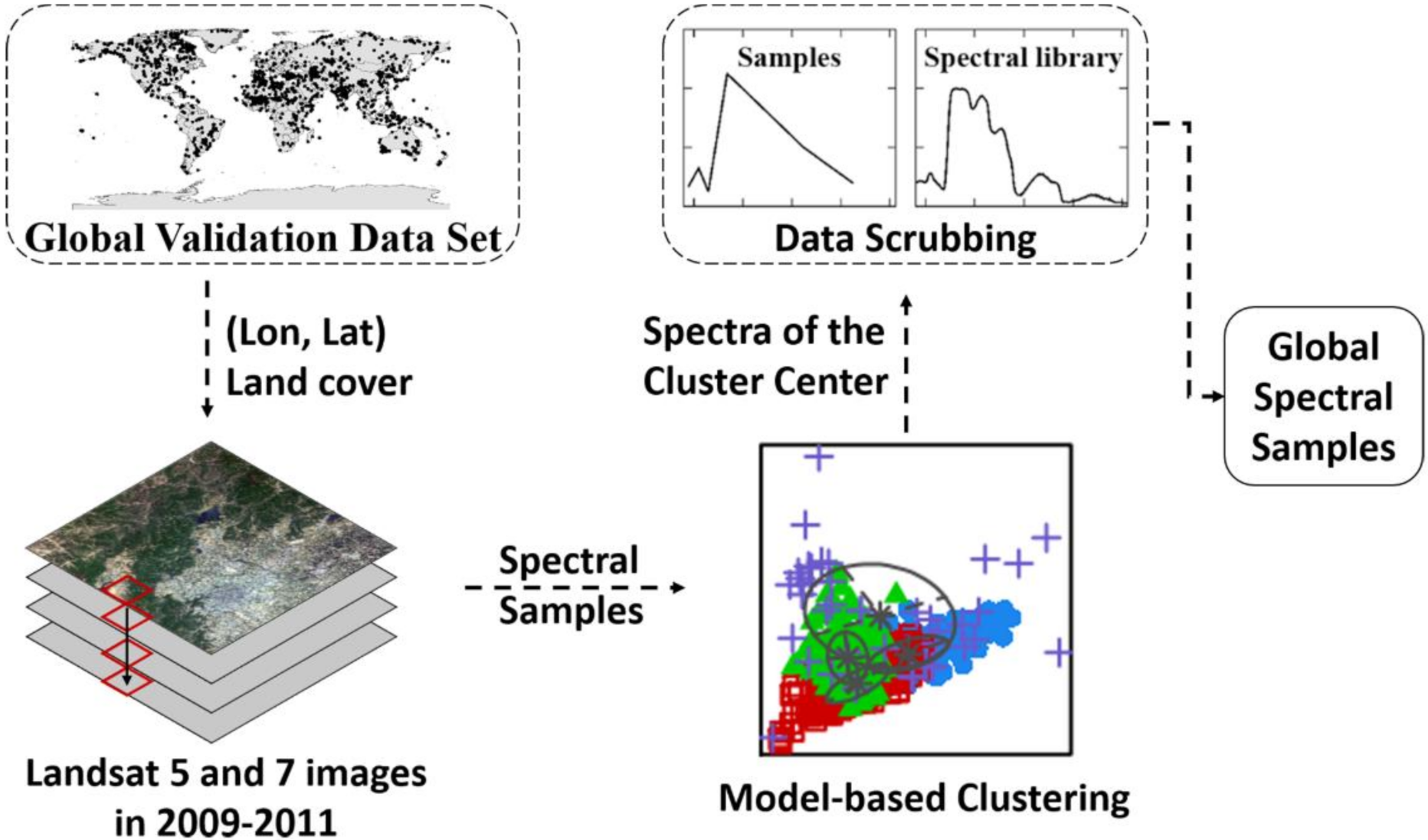

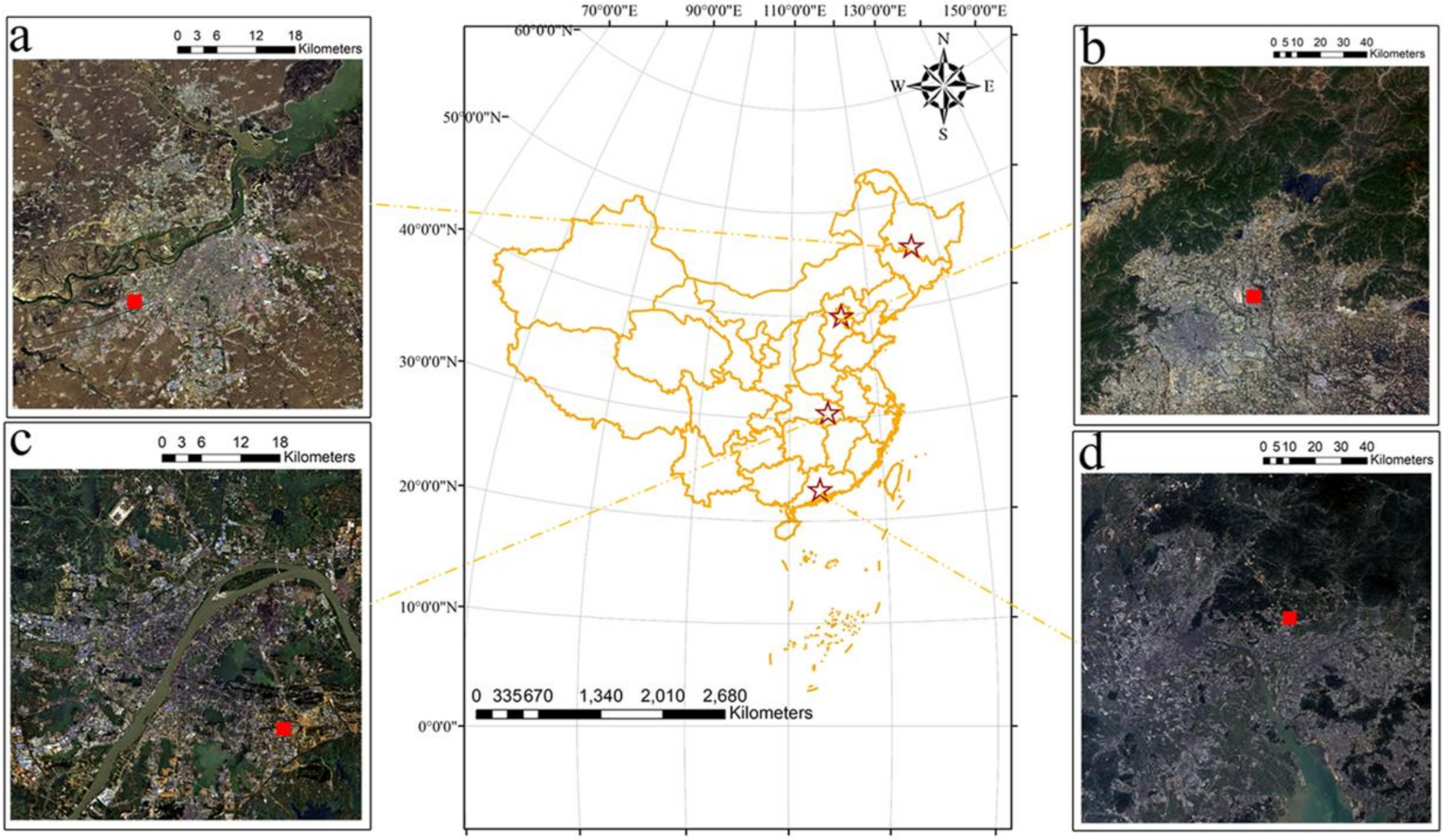



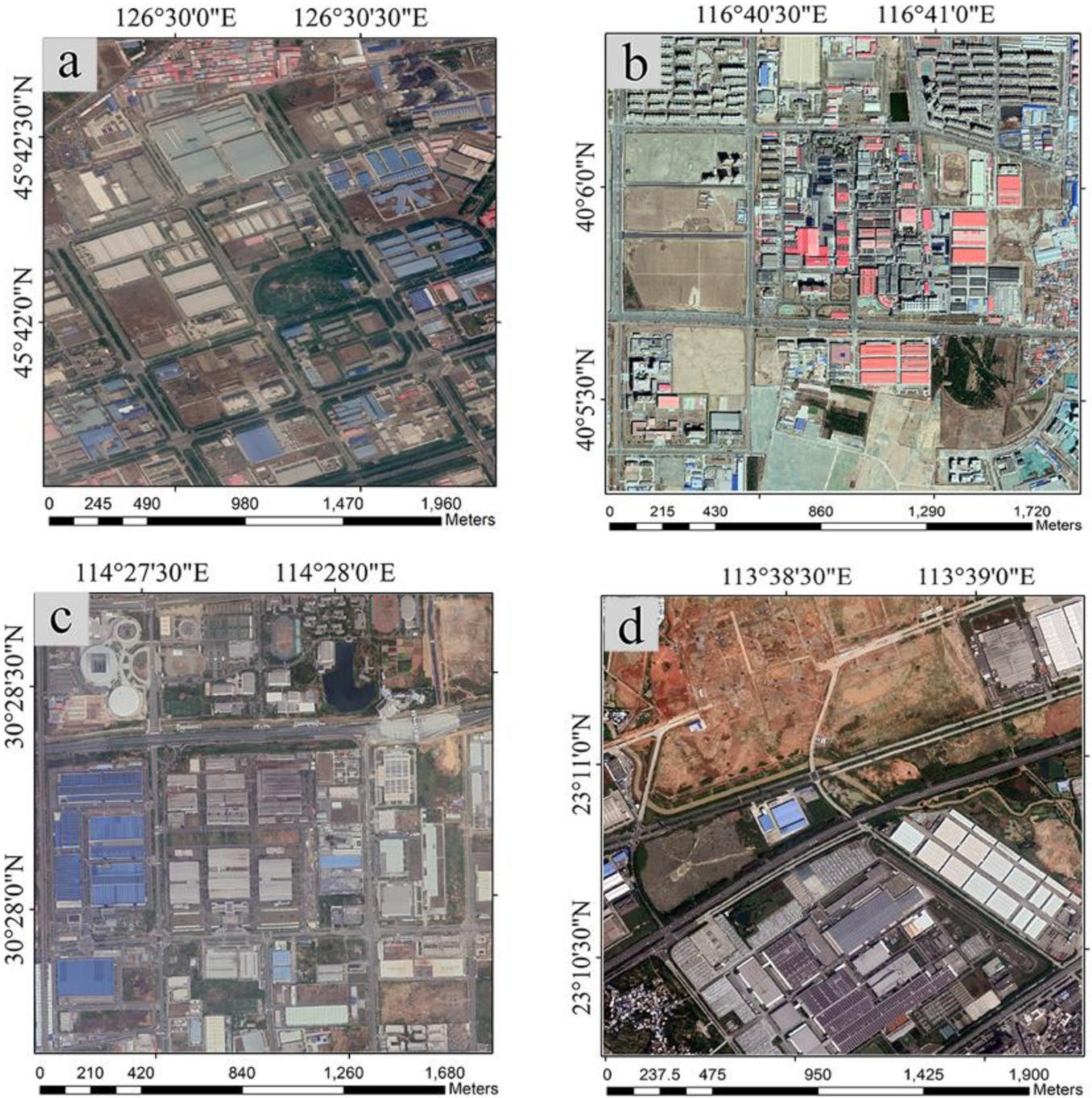
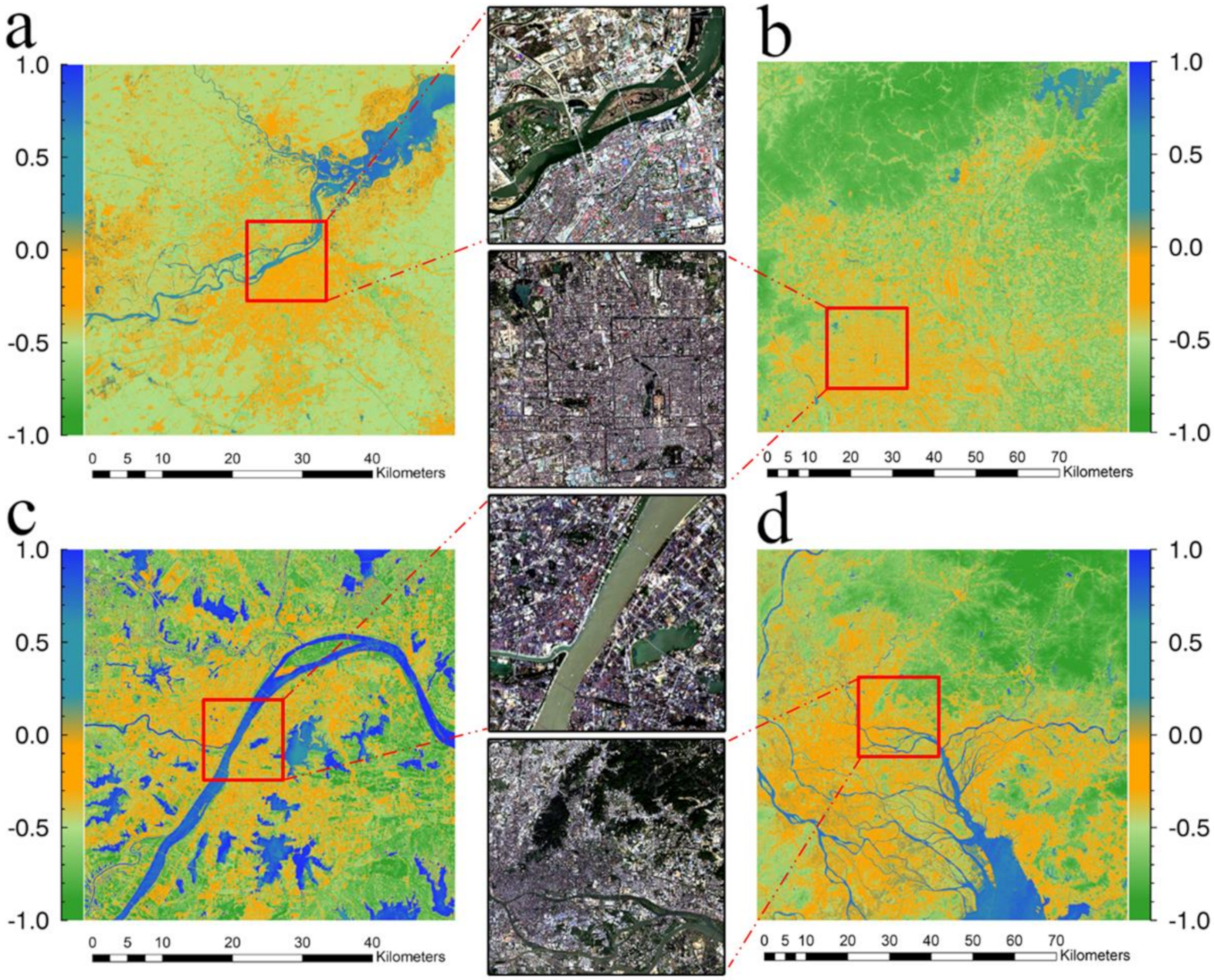

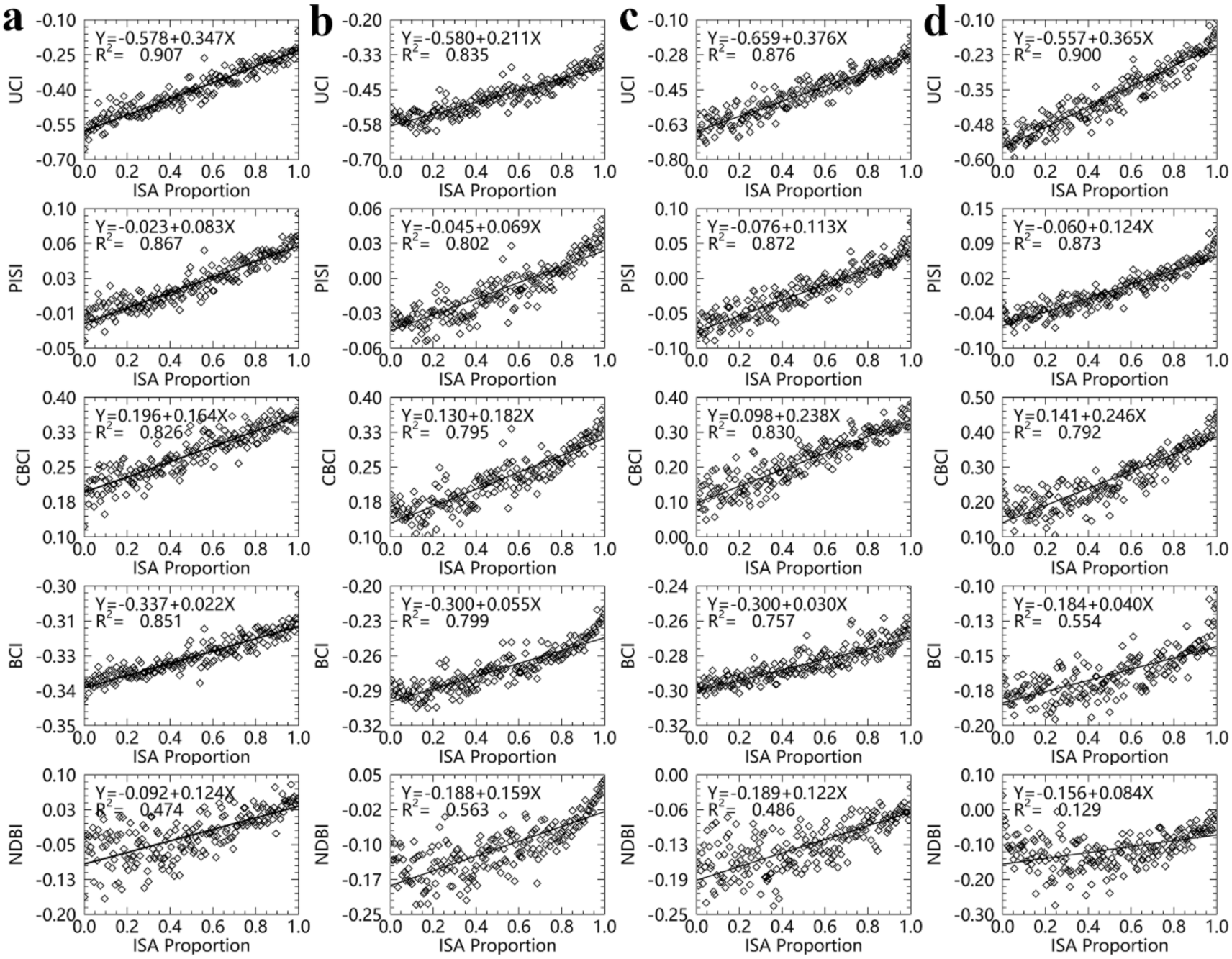
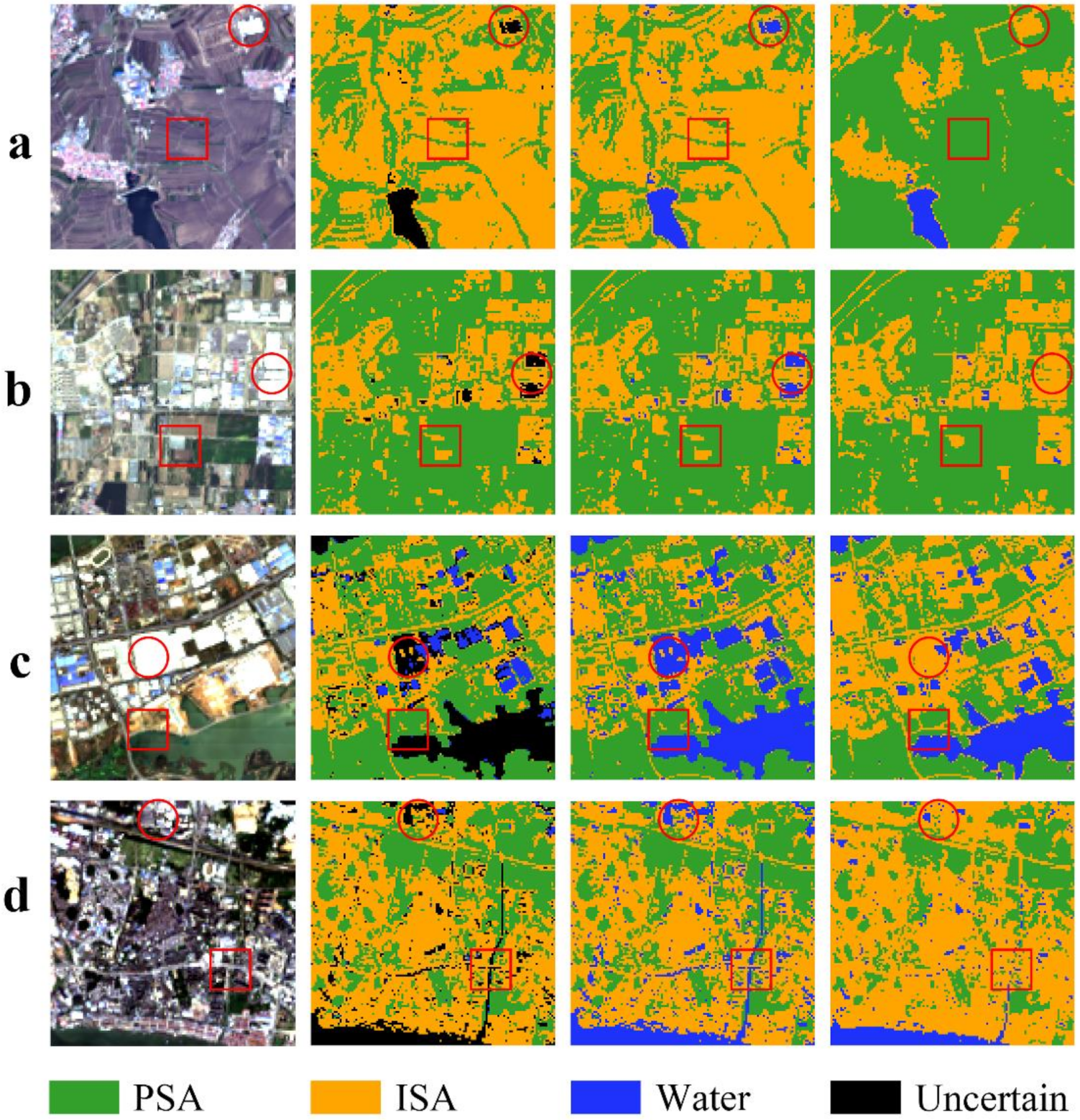

| Index | Description | Urban Compositions | Reference |
|---|---|---|---|
| NDWI | Normalized difference water index | Water | [25] |
| MNDWI | Modification normalized difference water index | Water | [26] |
| NDVI | Normalized difference vegetation index | Vegetation | [27] |
| NDBI | Normalized difference built-up index | ISA | [28] |
| NDISI | Normalized difference impervious surface index | ISA | [5] |
| BCI | Biophysical composition index | Soil, ISA and vegetation | [29] |
| MNDISI | Modified normalized difference impervious surface index | ISA | [30] |
| PISI | Perpendicular impervious surface index | ISA | [31] |
| CBCI | Combinational biophysical composition index | Water, soil, ISA and vegetation | [32] |
| ENDISI | Enhanced normalized difference impervious surfaces index | ISA | [33] |
| Study Areas | Date of Landsat-8 Images | Path/Row Landsat-8 | Date of Google Earth Images | Wavelength (μm) of Landsat-8 |
|---|---|---|---|---|
| Harbin | 7 May 2018 | 118/28 | 14 May 2018 | Band1 (Coastal): 0.435–0.451 |
| Band2 (Blue): 0.452–0.512 | ||||
| Beijing | 13 May 2019 | 123/32 | 24 March 2019 | Band3 (Green): 0.533–0.590 |
| Band4 (Red): 0.636–0.673 | ||||
| Wuhan | 15 September 2018 | 123/39 | 16 September 2018 | Band5 (NIR): 0.851–0.879 |
| Band6 (SWIR1): 1.566–1.651 | ||||
| Guangzhou | 23 October 2017 | 122/44 | 17 September 2017 | Band7 (SWIR2): 2.107–2.294 |
| Index | Harbin | Beijing | Wuhan | Guangzhou | Global |
|---|---|---|---|---|---|
| UCI | 1.60 | 1.37 | 1.39 | 1.38 | 1.20 |
| PISI | 0.91 | 1.05 | 1.32 | 1.33 | 0.85 |
| CBCI | 0.82 | 0.82 | 1.04 | 1.31 | 0.91 |
| BCI | 1.03 | 0.81 | 1.15 | 0.50 | 0.40 |
| NDBI | 0.95 | 0.44 | 0.48 | 0.86 | 0.51 |
| MNDWI | 1.34 | 0.63 | 0.32 | 0.71 | 0.98 |
| Index | Harbin | Beijing | Wuhan | Guangzhou | Global |
|---|---|---|---|---|---|
| UCI | 2.00 | 1.80 | 1.99 | 2.00 | 1.91 |
| PISI | 1.06 | 1.18 | 0.38 | 0.90 | 0.63 |
| CBCI | 1.87 | 1.51 | 1.35 | 1.82 | 0.73 |
| BCI | 1.04 | 0.58 | 1.20 | 0.25 | 0.61 |
| NDBI | 1.63 | 0.90 | 1.43 | 1.87 | 1.28 |
| MNDWI | 2.00 | 1.89 | 2.00 | 2.00 | 1.93 |
| Index | Harbin | Beijing | Wuhan | Guangzhou | Global |
|---|---|---|---|---|---|
| UCI | 2.00 | 1.98 | 2.00 | 2.00 | 2.00 |
| PISI | 2.00 | 1.83 | 1.88 | 1.91 | 1.26 |
| CBCI | 2.00 | 1.77 | 1.91 | 1.97 | 1.27 |
| BCI | 2.00 | 0.85 | 1.17 | 1.13 | 0.92 |
| NDBI | 1.94 | 0.22 | 0.85 | 0.48 | 0.52 |
| MNDWI | 2.00 | 1.99 | 2.00 | 2.00 | 2.00 |
| Index | Harbin | Beijing | Wuhan | Guangzhou | Global | |||||
|---|---|---|---|---|---|---|---|---|---|---|
| OA | Kappa | OA | Kappa | OA | Kappa | OA | Kappa | OA | Kappa | |
| UCI | 97.17 | 0.96 | 93.13 | 0.89 | 91.09 | 0.85 | 93.13 | 0.89 | 94.60 | 0.91 |
| PISI + | 67.11 | 0.50 | 92.22 | 0.88 | 86.72 | 0.79 | 90.61 | 0.85 | 91.58 | 0.85 |
| UCI * | 98.19 | 0.97 | 97.68 | 0.96 | 94.52 | 0.91 | 95.39 | 0.93 | 95.44 | 0.93 |
| CBCI * | 87.44 | 0.81 | 83.53 | 0.74 | 89.97 | 0.84 | 92.46 | 0.88 | 87.47 | 0.77 |
| BCI *+ | 92.62 | 0.89 | 90.23 | 0.85 | 92.11 | 0.87 | 85.41 | 0.77 | 84.78 | 0.76 |
| NDBI *+ | 51.18 | 0.26 | 73.84 | 0.60 | 76.51 | 0.62 | 84.24 | 0.75 | 73.40 | 0.53 |
Publisher’s Note: MDPI stays neutral with regard to jurisdictional claims in published maps and institutional affiliations. |
© 2020 by the authors. Licensee MDPI, Basel, Switzerland. This article is an open access article distributed under the terms and conditions of the Creative Commons Attribution (CC BY) license (http://creativecommons.org/licenses/by/4.0/).
Share and Cite
Zhang, L.; Tian, Y.; Liu, Q. A Novel Urban Composition Index Based on Water-Impervious Surface-Pervious Surface (W-I-P) Model for Urban Compositions Mapping Using Landsat Imagery. Remote Sens. 2021, 13, 3. https://doi.org/10.3390/rs13010003
Zhang L, Tian Y, Liu Q. A Novel Urban Composition Index Based on Water-Impervious Surface-Pervious Surface (W-I-P) Model for Urban Compositions Mapping Using Landsat Imagery. Remote Sensing. 2021; 13(1):3. https://doi.org/10.3390/rs13010003
Chicago/Turabian StyleZhang, Lihao, Yugang Tian, and Qingwei Liu. 2021. "A Novel Urban Composition Index Based on Water-Impervious Surface-Pervious Surface (W-I-P) Model for Urban Compositions Mapping Using Landsat Imagery" Remote Sensing 13, no. 1: 3. https://doi.org/10.3390/rs13010003
APA StyleZhang, L., Tian, Y., & Liu, Q. (2021). A Novel Urban Composition Index Based on Water-Impervious Surface-Pervious Surface (W-I-P) Model for Urban Compositions Mapping Using Landsat Imagery. Remote Sensing, 13(1), 3. https://doi.org/10.3390/rs13010003





